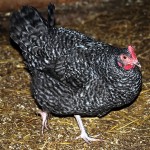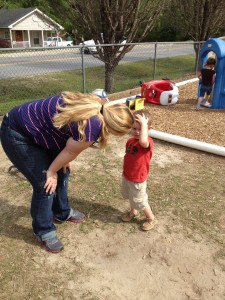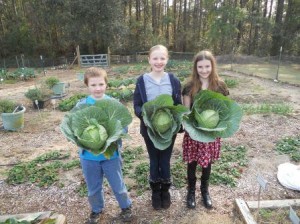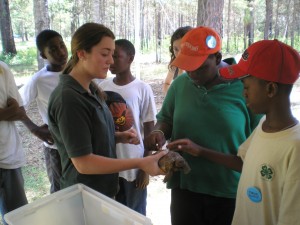by Whitney Cherry | Jul 8, 2013
The National Association of Extension 4-H Agents has awarded the 4-H agents in the Northwest Extension District of Florida their national award for Excellence in 4-H Volunteerism. This award is given to the agent or group of agents who show(s) an unequaled dedication to providing quality volunteer development programs. In our district, each county provides local volunteer training and development, but we also work as a district to bring you opportunities like our district-wide volunteer leader forum at 4-H Camp Timpoochee and district-wide shooting sports volunteer trainings in each discipline each year.
While the agents are to be congratulated for working hard and receiving this award, many thanks go to our wonderful volunteers throughout the district who support 4-H programming in Florida. Every club leader, project leader, camp volunteer, fair judge, and so on, is in part responsible for the success of Florida 4-H. We are so grateful for your unwavering dedication to 4-H Youth Development. Furthermore, we invite you to continue to help us “Make the Best Better” through our Make a Difference Monday’s volunteer training series. The series will begin August 19, 2013 and will run the third Monday of every month through April 2014. Your local extension office will be able to provide you with further details including topics for each session in the series.

by Sherri Kraeft | Jul 5, 2013
![1013441_659740687387883_254816366_n[1]](https://nwdistrict.ifas.ufl.edu/4hn/files/2013/06/1013441_659740687387883_254816366_n1-150x150.jpg) One word: Incentives
One word: Incentives
Youth enjoy 4-H summer camp because it provides a welcoming environment where they can learn and grow. They get to make new friends and participate in activities like, archery, swimming, canoeing, rocketry, kayaking, arts and crafts, and more. When they come home from camp singing camp songs and relating their awesome experiences, they encourage their friends at school as well as fellow club members to come with them during the next year. With this in mind, how can club leaders and other volunteers encourage youth to participate in camp if they have never attended or have never considered attending?
At this time of year, camps may already be over for your county 4-H program, but it is never too early to start planning for next summer. As club leaders, when you begin thinking about fundraising and club program planning for the fall, consider incorporating some “camp incentives” for youth who might want to plan to attend camp next year. Here are a few ideas:
- Include fundraising percentages or credits given to members who participate in and plan club fundraisers. Maybe 10% of the funds they raise for the club in a particular fundraiser will go to their camp fees, etc.
- You may offer full or partial scholarships to youth who demonstrate leadership or take on an officer role in a community club setting.
- Allow 4-H members who turn in a completed and well-produced project book to be rewarded at the awards banquet with a camp price reduction or prize to be used in conjunction with camp attendance such as a club t-shirt or goodie bag with camp related items.
While funding for camp can introduce challenges for some club members, these obstacles when handled appropriately and quickly can provide terrific learning opportunities for youth who earn their way to attend camp and have a wonderful experience while there.
by Whitney Cherry | Jun 21, 2013

Photo Credit: http://montessorimeetmot.blogspot.com/2012/04/neatfun-ideas.html
It’s summer time finally, and our kids are glad to be out of school, but it won’t be long before they are bored and itching for some fun. I’ve put together a boredom buster that you can use at home, in 4-H club meetings, 4-H school enrichment programs, or in 4-H day camps based on this great picture I found. Creating a grass hand print is very simple and doesn’t require any special equipment:
Materials
- Container to plant in (Make sure that the top of the container is large enough for your hand print. Pie plates work great and are super cheap!)
- Potting soil
- Grass seed
- Writing utensil (pen, pencil, marker, etc)
- Scissors (preferable safety scissors)
- Construction paper or card stock
- Water
Instructions
- Using your writing utensil, trace your hand on a piece of construction paper.
- Use the scissors to cut out the image you just traced of your hand.
- Fill your container nearly to the top with potting soil. You will want to leave at least an inch of space.
- Immerse your paper hand print in the water.
- Remove your paper hand print from the water quickly and lay it out on a flat surface.
- Sprinkle grass seed over the paper hand print until it is covered.
- Lay the seed covered hand print on top of the dirt in the container and cover it with about a quarter inch of soil.
- Make sure that the pot receives adequate sunlight and water as directed on the seed packet your seeds came from. In a few days you should have a grassy hand print!
So that’s it! This is a great introductory lesson to gardening or plant sciences, and it’s just plain cool. For more information on 4-H gardening projects, resources, and competitions visit: http://florida4h.org/programs/Plantscience.pdf
by Whitney Cherry | May 31, 2013

Volunteering in the Panhandle is a publication for 4-H volunteers and is provided by 4-H Extension Agents in Northwest Florida.
The team of 4-H Extension Agents in the Northwest District of Florida are very excited to be launching our Volunteering in the Panhandle Facebook page and Twitter feed. Please like us, follow us, or check in every so often. We will still be publishing the newsletter on our website, and we will of course, continue to send out e-mail messages via the subscription management system when we post something new, so if you don’t use Facebook or Twitter, there is no reason to worry. You will still be in the loop!
Add our website to your favorites: https://nwdistrict.ifas.ufl.edu/newsletters/category/volunteering-in-the-panhandle/
Sign up to receive e-mail updates: http://subscribe.ifas.ufl.edu/ (It’s free, and you can opt out at any time with no hassle. Your information is not being shared with anyone!)
Follow us on Titter: https://twitter.com/NWD4_H
Like us on Facebook: https://www.facebook.com/VolunteeringInThePanhandle
by Julie Pigott Dillard | May 24, 2013
 There’s a home agricultural movement sweeping the United States. Raising chickens in the backyard, not only in rural settings but also urban and suburban areas, is quickly gaining in popularity. Chickens are very social animals and provide not only enjoyment, but high quality, nutritious eggs. Several websites promote and advocate raising chickens in urban/suburban locales and provide readers information on building coops, breed information, incubation and hatching, growing your own chicken feed and protecting chickens from disease. Search on Pinterest and you’ll find coops and chicken breeds of every shape and size.
There’s a home agricultural movement sweeping the United States. Raising chickens in the backyard, not only in rural settings but also urban and suburban areas, is quickly gaining in popularity. Chickens are very social animals and provide not only enjoyment, but high quality, nutritious eggs. Several websites promote and advocate raising chickens in urban/suburban locales and provide readers information on building coops, breed information, incubation and hatching, growing your own chicken feed and protecting chickens from disease. Search on Pinterest and you’ll find coops and chicken breeds of every shape and size.
Egg incubation and hatching is another aspect of 4-H poultry projects that is awe-inspiring for our youngest to oldest 4-H’ers. To think that a baby chick forms in only 21 short days is amazing.
Raising poultry is a relatively inexpensive and easy 4-H project for youth to begin. Chickens require little space, feed is readily available, and compared to large, traditional 4-H livestock projects, care is minimal. But before you send club members to the local farm supply store or order chicks or fertilized eggs from an online vendor, check city ordinances so that they are in compliance.
In my hometown of Chipley, the rules are quite simple:
- pens must be cleaned regularly and kept sanitary
- pens cannot be within 100 feet of a residence
Tallahassee, however, has three very specific rules with four very specific exceptions. To explore your city’s municipal codes, visit municode.com, select state followed by city. Entering poultry or chickens in the search box should take you directly to ordinances on this subject.
Julie Pigott Dillard is the 4-H Youth Development Agent and Director of UF IFAS Washington County Extension. Having raised chickens growing up, she now enjoys it with her oldest son and parents who have a unique assortment of both production and exhibition breeds. They also teach poultry classes for youth and adults. During the past two weeks, they have hatched two dozen chicks! juliepd@ufl.edu
by Monica Brinkley | May 10, 2013

Sewing is much more than just making a garment or a bag, instead it is the vehicle to teach self-confidence through skill building.
In today’s world, sewing is no longer a necessity as it was in our mothers’ and grandmothers’ day. Most women of that era knew how to sew and could clothe their families by using their sewing skills. Now, sewing can be expensive, so why should children be taught to sew?
The goal of teaching children, and adults for that matter, to sew is to gain self-confidence as they learn a new skill. Hand sewing skills develop finger dexterity and the development of fine motor skills. If you have ever hand sewn you know it can also teach you the value of patience. These skills can be used not only to create beautiful pieces of art and heirlooms to be passed down, they are the same skills needed to mend cloths. Knowing how to put a hem back in pants and skirts as well as how to sew a button back on a garment is extremely important and can be very expensive to have done.
Sewing teaches listening and following of directions. Either a student listens to or reads directions in order to complete a project. Reading and following a pattern is the hardest part of sewing for many people. Throughout life we follow directions. In our modern world we listen to the GPS to aid us in reaching a destination or follow the printed map. Did you make the connection between sewing and reaching a destination?
Not only can basic skills be taught through sewing, there is a lot of science, technology, engineering, and math that can be taught. Many creative people are also great engineers. A lot of the modern sewing machines are computer driven. Just learning to operate some of them takes a technologically minded person. Think of the science that goes into engineering the new fibers that are used to make not only clothing but all the other items we use made of fibers. And the measurement skills, addition, and subtraction that go into sewing are naturally math concepts.
Sewing is much more than just making a garment or a bag, instead it is the vehicle to teach self-confidence through skill building. If you don’t know how to sew yourself, either learn or find another volunteer who has the skill. Let’s teach youth skills they will carry with them throughout life.
by vmullins | Apr 26, 2013

Teens learn valuable life skills through volunteering with 4-H.
Summer – no school, lots of time – what’s a teen 4-Her going to do? Many teens will be searching for jobs. Some will be looking for summer employment to pay for 4-H events, or earn extra spending money, or save for a car, clothes or college. But will they find a job? Some won’t. If they can’t get a job, encourage them to volunteer!
The current job market is dismal. Pick up any newspaper, turn on any news program or just listen to the people around you. It’s hard to get a job! The job employment rate for American teens is at an all-time low.
Teens that are fortunate enough to obtain a summer job are also handed a mixed blessing. The job may prevent them from participating in summer vacations and activities with family and friends. The cost of working: taxes, transportation, clothing or uniforms, meals etc. may leave little in net income. And 4-Hers who have jobs often have to forego summer 4-H events . So how do we help teens make the best of their summer and also help prepare them to enter the workforce?
The skills and knowledge that a teen could gain through a “paid” job can also be gained through volunteering. There are many benefits of volunteering instead of working in the summer including:
- Volunteering provides more flexible scheduling allowing teens to participate in 4-H and other summer activities.
- Volunteering provides opportunities for teens to serve as teen leaders, peer educators and role models to younger 4-Hers and other youth. This also allows teens to utilize their 4-H project skills and knowledge and enhances their 4-H portfolio and resume.
- Volunteering provides teens opportunities to investigate different career fields and future jobs in places that they are allowed to volunteer but where they could not be employed, because of personnel policies or their age, lack of knowledge, skills or experience.
- Many college degree fields have a “volunteer or work” hours of experience requirement that must be met before an applicant can be admitted to the degree program.
- Volunteer hours of service are often a criteria for awarding scholarships.
- Supervisors of volunteers make excellent references and volunteer work can usually be counted as job experience even though it is “unpaid.”
- Volunteering offers teens opportunities to network with others. Remember the old adage “it’s not what you know, but who you know” is still true in many instances.
However for the Volunteer experience to be beneficial, teens must treat the volunteer job with the same respect as a “real” job. They must be willing to learn and exhibit life skills and good work ethics including:
- Punctuality, dependability and dedication
- Honesty, integrity and confidentially
- Initiative and self-motivation
- Teamwork and loyalty
- Communication skills
- Willingness to accept criticism and desire to improve
So for teens that can’t find or don’t want to work this summer, remember volunteering offers many benefits.
by Stefanie Prevatt | Apr 12, 2013
April kicks off the global month of service. If you are responsible for guiding and organizing service learning projects for your 4-H Club (or any other organization), follow this five step process to ensure a successful, enriching experience for all involved:
1. Assess.
Who (or what) needs help in your local community? Ask for youth input for a specific area, location, or population.
2. Plan.
Define learning objectives for the project. These can be general or specific, but the service project should be guided by an educational goal.
3. Participate.
To engage youth in a true service learning experience, ask reflection questions during the actual service project.
4. Analyze and Generalize.
Immediately following the experience, ask questions to learn how youth felt while they were engaged in the service project, such as: “What was the most difficult task you did today?”
To generalize is to understand the “so what.” Ask questions like: “What did you learn about yourself while completing this project?”
5. Apply.
Ideally, service learning is a continuous process. Whether giving an illustrated talk on increased awareness of animal abuse or volunteering at a local hospital on their own time, service learning hopes to foster “self-worth, citizenship, critical thinking skills, [and ] responsibility” in youth (Mashburn, Harder, & Pracht, 2011).
For more information on how to can make community service more enriching and meaningful for youth and adults:
Mashburn, D., Harder, A., & Pracht, D. (2011). Learning by doing: Utilizing service-learning projects (AEC392). Gainesville: University of Florida Institute of Food and Agricultural Sciences. Retrieved August 23, 2012 from http://edis.ifas.ufl.edu/wc073#FIGURE%201

The Leon County 4-H Horticulture Club grew and donated over 150lbs of fresh vegetables to local food banks in 2012.
by Niki Crawson | Mar 29, 2013
Spring and summer seasons can seem like a busier time than normal for 4-H volunteers. Between 4-H/Tropicana, shooting sports matches, volunteer trainings and upcoming summer day camps, 4-H becomes a world of its own with wonderful youth development opportunities to teach needed life skills to our youth. However, with the busy season approaching, concern of the dreaded VOLUNTEER BURNOUT is real. It typically rears its ugly head starting in April and really takes a hold by June. By July, it has claimed more volunteer victims than we like to admit. It is dark, ugly, and heavy. It preys on the unsuspecting, the tired, the unselfish.

Do you feel the burn?
What causes volunteer burnout, and how does one recognize it before it attacks? Volunteer burnout can be a result of one or more factors such as over commitment, lack of sufficient breaks and rest, excessive responsibilities, an inability to say “no” and so on. Volunteer burnout will typically prey on the loyal, unselfish, dedicated volunteer who wants to make a difference but may do so too much, too fast, and/or too often. The only way to avoid volunteer burnout is to…take time for YOU.
“Wait, what? Take time for myself? But what about the youth I am positively impacting through 4-H?” you may ask. Well, the old saying “you cannot help others if you are not taking care of yourself first” applies here. In order for this to occur, you have to tend to yourself and have a healthy balance established between your needs, your family, work, etc.
If you are concerned that you are starting to feel the effects of volunteer burnout, talk to your 4-H Agent immediately. Find out what can be done to help you ease the burden you are feeling. Sometimes, it is a simple solution of talking through your concerns and frustrations regarding your schedule and setting priorities and new boundaries. Other times it may mean getting more sleep, exercise, or starting a hobby that relaxes you. Then again, sometimes it may require that more drastic measures be implemented such as giving up a task, learning to say “no” more often or even taking a few weeks off from your volunteer duties to tend to your own needs by enjoying the beautiful weather and working in your garden.
So, before you let the nasty volunteer burnout monster bite and send you running from the wonderful 4-H program you are involved in, we urge you to maintain a healthy balance between dedicated and delirious. Take time for yourself. Eat healthy. Exercise regularly. Spend quality time with family and friends. Enjoy the spring days. Visit the UF IFAS EDIS website (http://edis.ifas.ufl.edu/) for fantastic gardening tips. Remember that you have the 4-H family in your corner supporting you 100% in your need for a little “you” time!
by Marcus Boston Jr. | Mar 15, 2013

Youth learn about the habitat and calm nature of the Gopher Tortoise at the 4-H Wildiife and Outdoor Recreation Camp
Many youth today are suffering from a serious, preventable disorder that is the result of early age experiences and if not properly diagnosed or treated, may cause severe mental health issues up through adulthood. This disorder I’m referring to is called Videophilia. Videophilia can be described as the love of any form of electronic media. This media may be internet, movies, video games, cell phones, or just plain TV. Many youth are so attached to their video devices that they hardly ever go outside to see what’s going on in the natural world. In Richard Louv’s book “Last Child in the Woods” he calls this condition “Nature-Deficit Disorder”.
According to the Center for Environmental Health, consistent contact with nature has many health benefits including helping to ease attention-deficit disorder, aiding in cognitive development, enhancing creativity, and reducing stress. With so much emphasis on our communities becoming more sustainable in how they utilize resources, many environmentalist fear that the loss of contact with nature will weaken Americans commitments to conservation and biodiversity. These concepts will have more impact to the future of our world if they are introduced to youth as they matriculate through grade school. The earlier we teach them how to enjoy the great outdoors the better!
What is nature you may ask?? Nature can be Yellowstone National Park, The Appalachia National Forest, or it could be a clump of trees at the back of a neighborhood or in someone’s yard. To the scientific eye the clump of trees might not look like much but to a child it could be a life changing experience. Every 4-H club agenda that is developed should include a nature walk or some other outdoor activity. Additionally, 4-H residential and day camps provide perfect opportunities for both youth and adults to explore the great outdoors together. Most electronic programs and activities only require hearing and seeing, however providing an outdoor experience for 4-H youth will provide opportunities to hear, smell, touch, see and sometimes taste. Nature Deficit Disorder may be a growing disorder, but lucky for us, with programs like 4-H and great volunteers, it is a disorder that can be easily cured!


![1013441_659740687387883_254816366_n[1]](https://nwdistrict.ifas.ufl.edu/4hn/files/2013/06/1013441_659740687387883_254816366_n1-150x150.jpg)







